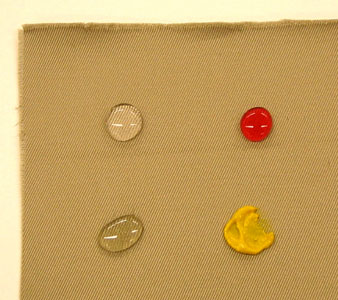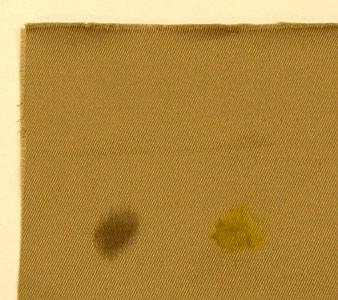Education and Outreach: Nanotechnology Activity Guides
Nano-Tex: Testing New Nano Fabrics
Audience: Middle school class
Time Needed: 50 minutes
Objectives:
- Introduce nanotechnolgy used in creating new fabric
- Understand the difference between dependent and independent variables
- Learn to develop hypothesis and experimentation
- Realize impact of technology in everyday things
Related Wisconsin Model Academic Science Standards:
- A.8.6 Use models and explanations to predict actions and events in the natural world
- C 8.1 Identify questions they can investigate using resources and equipment they have available
- D.8.4 While conducting investigations, use the science themes to develop explanations of physical and chemical interactions and energy exchanges
- ELA C.8.3 Participate effectively in discussion
- G.8.3 Illustrate the impact that science and technology have had, both good and bad, on careers, systems, society, environment and quality of life
Activity Materials:
-
Each group of 2-4 students should have the following:
• 6 swatches of stain-resistant fabric. We suggest going to a local department store and purchasing and cutting up a pair of pants or a shirt ($30-$40) made from the fabric. The brands listed on the Nano-Tex web site (http://www.nano-tex.com/products/where.htm) all carry items made from NANO-CARE® fabric. To be sure, just look for “nano” someplace on the label. The fabric can be reused a number of times, depending on how vigorously your students test it.
• 3 swatches each of 2-3 other fabrics. We usually use 100% cotton, a synthetic fabric like polyester, and/or a cotton/poly blend. Remnants can be purchased inexpensively from a fabric or craft store.
• Stain agents (see below)
• Beakers or cups to hold water and stain agents
• Eyedroppers for applying liquid stain agents
• Plastic knives or spoons for applying other stain agents
• Several buckets to hold detergent and water for washing fabrics, available at most hardware or convenience stores
• Laundry detergent and water
• Several large dish pans with low sides to put materials in when conducting experiments
• Stopwatches or clock with second hand
• 1 large sheet of paper or poster board
• Markers
• Sandpaper (optional)
• Scissors (optional)
• Microscopes (optional)
Cut the fabric so there are enough swatches for each group to test, per the materials requirements. Each swatch should be no smaller than 3 inches square.
Each individual student should have the following:
• A lab notebook or loose leaf for recording observations
• Lab coat or smock
Stain agents
It is important to have a wide variety of stain agents, as the stain-resistant fabrics are designed to repel some and not others. We suggest having a few from each category available for the students to try.
Liquids:
• Water
• Grape juice or fruit punch
• Cooking oil
Condiments:
• Ketchup
• Mustard
• Peanut butter
• Grape jelly
Others:
• Acrylic paint
• Fabric dye, like that used in tie-dying, available from any craft store
• Writing utensils like markers, pens, pencils, or chalk
• Dirt or potting soil
Activity Instructions:
Starting Points
If spilling soda, spaghetti sauce, or orange juice on themselves strikes your students with the fear of wearing dirty clothes among their peers, Nano-Tex, LLC, would encourage them to shop for pants and shirts made with NANO-CARE® fabric - pants and shirts that almost magically resist stains and repel water, giving us the ability to walk away from messy situations with clean clothes. Nano-Tex supplies material to many well-known brands (Nano-Tex).
What looks like magic in the Nano-Tex fabrics is actually the product of a science called nanotechnology, a cutting-edge field that deals with machines, materials, structures, and how they behave at the scale of atoms and molecules, or the nanoscale. By working on this small scale, scientists are able to create enhanced materials with desirable properties, such as stain-resistance.
Students should have a basic understanding of science inquiry and of atoms and molecules before beginning this activity. This activity would fit well into any unit about atoms and molecules, the nature of science, or inquiry. If you are interested in an interdisciplinary approach, this activity could also be combined with a social studies class studying advertising or mass communication.
Activity
We explain to students that a new fabric has come onto the market that claims to be extremely stain-resistant. Today they are going to be teams of researchers and put the claims to the test to see if this special fabric really is different from fabrics that we already wear every day. Is it really more stain-resistant? Do other properties suffer as a tradeoff?
Once students are in their groups, they should collect 3 swatches of each fabric, several stain agents, and a bucket containing water and detergent and spend 10 minutes investigating properties of the three different types of fabrics. In addition to investigating stain resistance, students may want to test water resistance, wrinkle resistance, or durability, as well as examine the general feel and texture of the fabrics. Students should record detailed observations in a laboratory notebook, including variables such as the amount of stain they used and the length of time the stain stayed on the fabric before they attempted to remove it.
We have found that students do not require much guidance for this portion of the activity. However, students tend to be extremely fascinated by the liquid-repellent properties of the Nano-Tex fabrics and may need to be prompted to turn their attention to the other fabrics.
After 10 minutes have elapsed, we ask the students if the claims of extraordinary stain resistance are true. Was the fabric particularly good at repelling certain stains but not others? How did the other properties of the Nano-Tex fabric compare to the other fabrics? The class has just performed a cursory investigation, but careful experimentation is often necessary to determine a material's true properties.
We start the second portion of the activity with a discussion of what makes a good scientific experiment. Scientists often first develop a hypothesis - an idea of why things behave the way they do - that is both specific and able to be proven false. This hypothesis is based on existing observations and investigations like the ones students made in the first part of the activity. Once scientists have a hypothesis, they design an experiment to test it.
We then discuss the characteristics of good experimental design. We emphasize the importance of having a control condition in order to assess baseline behavior, and we talk about the relationship between dependent and independent variables and why it is important to modify only one independent variable at a time.
We ask students to consider the technology behind the stain resistance and their earlier experiences. With this in mind, they should create a hypothesis about what will and will not cause stains on the Nano-Tex fabric. Students then design a simple experiment to test this hypothesis. Students' experiments should contain a control condition and one or two experimental conditions that focus on one independent variable and one dependent variable.
|
|
NANO-CARE ® fabric swatches with water, cranberry juice, mustard, and vegetable oil (clockwise from top left) as they appear after sitting on the fabric for 30 minutes (left) and the same fabrics after the stains have been wiped off with a wet paper towel (right). |
|
We have found that students often come up with a wide variety of hypotheses and experimental conditions. They may want to attempt to remove the nanotechnology with sandpaper or through repeated washings before staining. Students may want to let a particular stain agent sit on the fabric for varying lengths of time before trying to wash it off. Or they may want to try different classes of stain agents to see if the fabric is more vulnerable to a particular kind of stain. Groups should be encouraged to consult and collaborate with each other throughout the entire process like real researchers (Harwood, 2004). Some of their ideas may require supplies that might not be readily available, such as a microscope. If you can devote more than one class period to this activity, we suggest having the students design their experiment on one day and perform their experiment on a subsequent day in order to make sure you have all supplies on hand.
When the students have finished designing their experimental procedure, they should gather the supplies they need and carry out the tests. Like in the first part of the activity, we ask them to record detailed observations.
We lead the class in a discussion of the nature of science and the impact their research could have on the production and use of this fabric. We address conflicting results by stressing that this is the nature of science - scientists continually refine their experimental designs and methods to get the best data possible and then draw inferences from those. Discuss situations where it would be appropriate to accept one set of results over another when they conflict, for example, due to error.
We conclude this module by explaining that the Nano-Tex fabric gets its stain-resistant properties from an example of nanotechnology. The fabric is dipped in a solution of "nanowhiskers" - tiny fibers that are 1/1000 th the width of a normal cotton fiber. These fibers attach to the fabric like peach fuzz and create a cushion of air around the fabric. This makes the fabric more wrinkle-resistant and causes liquids to bead up and roll off. Because the fibers are on the nanoscale, they are invisible to the naked eye and do not affect the feel or breathability of the fabric
Required Background Information:
None
Supplemental Materials:
- Teacher's Guide: Sample Poster (pdf)
- Handout: Worksheet (pdf)
References:
-
Harwood, W. 2004. An activity model for scientific inquiry. The Science Teacher , 71(1): 44-46.
-
Maney, K. 2001. Nanotech advances in a new fabric. USA Today . Also available on-line: retrieved June 10, 2004 from http://www.usatoday.com/tech/columnist/cckev060.htm .
-
Nano-Tex, LLC. Retrieved June 10, 2004 from http://www.nano-tex.com .
-
National Research Council (NRC). 1996. National Science Education Standards . Washington D.C.: National Academy Press. Also available on-line: Retrieved June 11, 2004, from http://www.nap.edu/readingroom/books/nses/html/ .
Authors:
IPSE Interns: Yvonne Kao
IPSE Leadership Team: Wendy C. Crone, J. Aura Gimm, Wendy deProphetis, Greta Zenner, and Tom Derenne
| Return to this activity's summary page |
The Nanotechnology Activity Guides are a product of the Materials Research Science and Engineering Center and the Internships in Public Science Education Project of the University of Wisconsin - Madison. Funding provided by the National Science Foundation.




